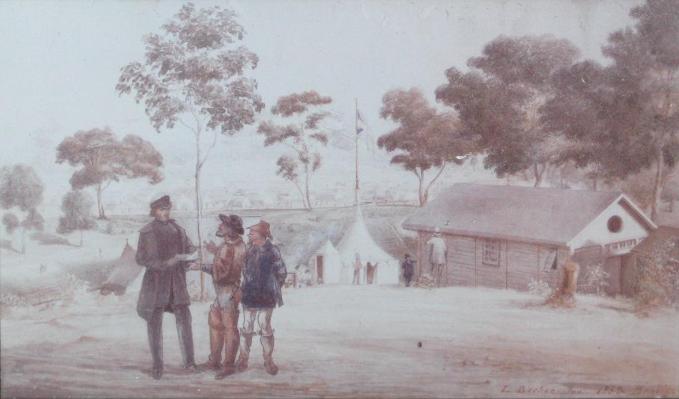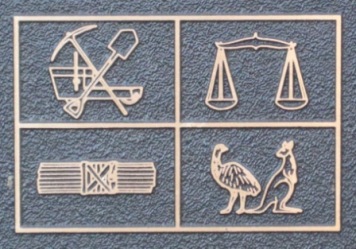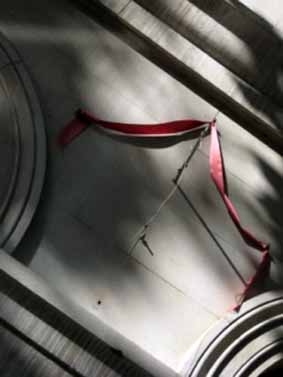Red Ribbon Rebellion
Contents
Background
Goldfields unrest and agitation against what was seen as an unjust Gold License fee centred in Bendigo in 1853. Large gatherings of diggers took place in Bendigo over the course of August 1853. Over 23,000 miners signed the Bendigo Miners' Petition, with over 10,000 people welcomed the petition representatives back to the diggings on 13 August, assembled under the Diggers’ Flag, designed by William Dexter.[1]
The Red Ribbon Agitation of 1853 was one of the earliest in the string of events that led ultimately to the Eureka Stockade uprising in Ballarat. Miners were required to pay a licence fee of 30 shillings a month whether they found gold or not.[2] This was seen as an unfair tax. The Red Ribbon Movement was active on the Bendigo diggings where diggers demanded a license fee from 30 shillings to ten shillings. The diggers planned to offer 10 shillings for a license and allow themselves to get arrested so as to cause overcrowding in the prisons, and an increase in administration.
The miners wanted land and they wanted representation. They were taking up the American cry of `no taxation without representation.`The Bendigo diggers held meetings and wore red ribbons to indicate that they would not pay the full license. The authorities in Bendigo were sensible and suspended the license for a month. That one month without the license fee being collected provided a relief valve for building tensions on the goldfields, but it was only temporary. More meetings and protests followed the 1853 Red Ribbon Rebellion, and miners continued to protest the license fee and advocate for changes, and the Red Ribbon sentiment spread to the other goldfields. Tensions eventually erupted in the Eureka Stockade on 03 December, 1854.[3]
The Red Ribbon
Agitators involved in the Red Ribbon movement (who sported red ribbons in their hats to symbolise their defiance of the law and the prohibitive licence fees imposed on lucky and unlucky miners alike) organised the Bendigo Goldfields Petition in mid-1853.
The miner’s used the colour red to signify unity and defiance against an unjust government. On 27 August 1853, ten thousand miner’s peacefully protested against the despised 30 shilling mining licence fee. Governor Charles La Trobe had rejected an earlier petition to axe the fee. Following the agitation, he agreed to removal of the fee for the month of September. Civil liberties and injustices continued until the height of agitations in 1854 at the Eureka Rebellion. [4]
The Diggers' Banner
William Dexter designed a flag that depicted a pick, shovel and cradle (labour); scales (justice); Roman bundle of sticks (Union); and an emu and kangaroo (Australia).
Bendigo Miners Petition
By the time the petition made its way to Melbourne, it had 23,000 signatures and had grown to 13 metres in length. The petition called for a reduction in monthly licence fees and land reform for diggers. Once thought to be lost, the petition was presented to the State Library of Victoria in 1988 by Melbourne collector, Dr John Chapman.[5]
Participants
Captain Brown
Captain George Harrison
160th Anniversary
The 160th anniversary of the red Ribbon Rebellion was held at Bendigo's at Rosalind Park in August 2103. The Golden City Pipe Band led the revolt, piping loudly through Rosalind Park. St Kilian's Primary School, Camp Hill Primary School and Girton Grammar students donned the red ribbon, marching as disgruntled miners.[6]
Bendigo’s Historical Society president Jim Evans said the rebellion marks the “road to democracy”. “This is an important event for Australia and for our democracy, he said. “The miner’s fought against an arbitrary government and won their rights on the goldfields eventually leading to the Eureka Stockade.”[7]
Also See
Ballarat Reform League Inc. Bendigo Monuments
References
- ↑ http://www.egold.net.au/biogs/EG00240b.htm, downloaded 15 March 2013.
- ↑ http://monumentaustralia.org.au/monument_display.php?id=30387&image=0, downloaded 15 March 2013.
- ↑ http://monumentaustralia.org.au/monument_display.php?id=30387&image=0, downloaded 15 March 2013.
- ↑ Bendigo Weekly, 27-Aug-2013.
- ↑ http://www.egold.net.au/biogs/EG00240b.htm, downloaded 15 March 2013.
- ↑ Bendigo Weekly, 27-Aug-2013.
- ↑ Bendigo Weekly, 27-Aug-2013.


